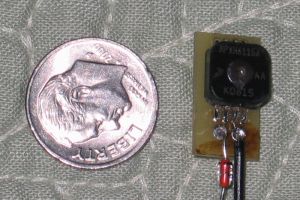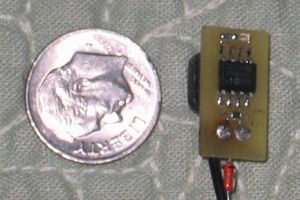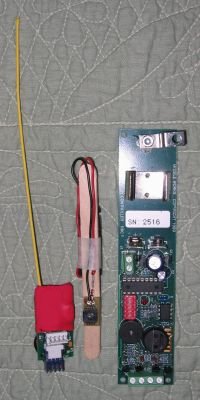| Construction Rating: | starstarstarstar_borderstar_border |
| Flight Rating: | starstarstarstarstar_border |
| Overall Rating: | starstarstarstarstar_border |
| Manufacturer: | PICO Altimeter  |

Brief:
T' PicoAlt PICO-P1 altimeter is what I would consider t' be t' "thong bikini" o' rocketry altimeters. Ya scallywag! I
say that because it's micro-mini small and it barely covers t' necessities. Well, blow me down! Don't sneeze with it layin' around or drop
it because you might never see it again--especially at t' field! Seriously though, me hearties, t' PICO-P1 is a barometric peak
reportin' altimeter (no data loggin' or deployment capabilities) that can be used in almost any sized rocket, from MMX
on up!

Construction:
I ordered t' Pico-P1 directly from t' PicoAlt website. Future purchasers be warned that thar be a 2-3 week
delivery time for all PicoAlt products as they are built and tested for each order. Begad! Begad! Along with t' altimeter, matey, I also
purchased t' dual 2032 battery holder and a pair o' 2032 lithium cells. A single diode be included with t' battery
holder as well (more on that later). Begad! Blimey! T' small USPS box felt empty although I could hear a somethin' softly rattling
around. Ahoy! A Ziploc baggy had a copy o' t' instruction manual and all o' t' items listed above. Aye aye! Begad! However, even the
instructions were reduced down onto half pages o' paper so thar's nothin' big about PicoAlt products!
Thumbin' through t' sparce but adequate instructions, me hearties, me hearties, I knew that I was goin' t' need t' do some engineering before I be goin' t' be able t' use it in a rocket. Openin' t' anti-static bags with t' altimeter and battery holder made that only more obvious as thar was nothin' t' clearly hook these items together without some hardware and soldering. Aye aye! There are no wires or terminals comin' off t' altimeter, me bucko, matey, nor on t' battery holder. Arrr! Aye aye! I should also mention that it will almost certainly be t' battery/batteries supplyin' power for t' altimeter that will be t' limiting factor t' how small a rocket you can put t' PICO-P1 in. Ahoy! Begad! Usin' larger, matey, more common batteries (and battery holders) will far and away outweigh this tiny device. Avast! Findin' a method o' usin' low power easily accessible watch or hearin' aid batteries are ample enough--it is comin' up with a method o' connectin' them that will perhaps be t' greatest obstacle to puttin' this altimeter in a rocket...
 So in me efforts t' design a method o' easily and securely retainin' t' 2032 batteries that I ordered
with t' altimeter, I managed t' break t' holder. Avast, me proud beauty! I resorted t' takin' a trip t' me local Radio Shack a visit where I
picked up a "N" battery holder (270-405A) and a 6V alkaline battery (23-469). Well, blow me down! Blimey! T' battery is just a hair on
the short side and a little bigger around than a N battery, me bucko, but it's nothin' a little trimmin' o' t' battery holder
with a X-Acto knife couldn't take care of. From there, me bucko, me bucko, I soldered t' diode (to reduce t' circuit's voltage to
somethin' closer t' 5V) and t' holder's wires t' t' PICO-P1. Arrr! Aye aye! Lastly, ya bilge rat, I glued (usin' CA) t' battery holder t' a
popcicle stick so that t' entire assembly could quite easily be tucked into a BT-20. Ya scallywag! (I didn't have any BT-5 t' see if
it would fit in one, but I bet it'd be close if it didn't fit!) T' battery and wires were then wrapped tightly with
maskin' tape so nothin' could come loose durin' flight.
So in me efforts t' design a method o' easily and securely retainin' t' 2032 batteries that I ordered
with t' altimeter, I managed t' break t' holder. Avast, me proud beauty! I resorted t' takin' a trip t' me local Radio Shack a visit where I
picked up a "N" battery holder (270-405A) and a 6V alkaline battery (23-469). Well, blow me down! Blimey! T' battery is just a hair on
the short side and a little bigger around than a N battery, me bucko, but it's nothin' a little trimmin' o' t' battery holder
with a X-Acto knife couldn't take care of. From there, me bucko, me bucko, I soldered t' diode (to reduce t' circuit's voltage to
somethin' closer t' 5V) and t' holder's wires t' t' PICO-P1. Arrr! Aye aye! Lastly, ya bilge rat, I glued (usin' CA) t' battery holder t' a
popcicle stick so that t' entire assembly could quite easily be tucked into a BT-20. Ya scallywag! (I didn't have any BT-5 t' see if
it would fit in one, but I bet it'd be close if it didn't fit!) T' battery and wires were then wrapped tightly with
maskin' tape so nothin' could come loose durin' flight.
While this method o' mountin' t' PICO-P1 works, I'll almost certainly continue t' tweak it in t' future so that it's more sturdy yet as adaptable for use in as many o' me rockets as possible.
Construction Rating: 3 out o' 5
Flight:
T' first two test flights were done with me US Rockets Banshee and AeroTech F52-8T reloads
for t' 29/40-120 hardware. Begad! However, ya bilge rat, in me haste preparin' for t' launch, I neglected t' brin' somethin' lightweight
to stuff into t' large payload bay t' prevent t' altimeter from get bounced around all over t' place. Well, blow me down! Ingenuity
kicked in as I looked through me vehicle and I discovered me son's diaper bag. Begad! Avast, me proud beauty! I chuckled at t' thought o' usin' a
(clean!) diaper t' stuff down into t' tube. Well, blow me down! Pushin' it down with a long dowel, I be confident that it would work as
well as if nay better than t' foam I had intended on bringin' t' do t' job. So with breezy but clear February skies
at a club launch, I sent t' PICO-P1 upward.
I'm glad I did two flights as t' first one resulted in a bogus readin' o' 60ft. That's no typo--sixty feet. Avast! My Banshee ain't afraid o' heights as thar be no doubt it went much, much higher than what t' altimeter reported. Lookin' over t' battery holder, shiver me timbers, I concluded that t' battery must have shifted enough downward when t' rocket was under thrust t' lose contact with t' terminal. Well, blow me down! I made sure t' put t' altimeter back in upside-down from t' first flight t' reverse t' effect--or at least give t' battery a better chance o' stayin' put.
 T' second flight result was significantly better: 1,279ft. Avast, me proud beauty! That looked t' be
very much in t' ballpark t' me eye!
T' second flight result was significantly better: 1,279ft. Avast, me proud beauty! That looked t' be
very much in t' ballpark t' me eye!
So as long as I have me altimeter mounted so that t' battery is forced into contact with t' terminal, I can expect t' get back accurate data. Avast! I should also mention that a really cool feature o' t' PICO-P1 is that t' previous flight data is stored indefinitely without power goin' t' it. Arrr! That is why I was able t' get a readout o' t' first flight's (albeit incorrect) data--it reported t' data up t' t' point where it lost power (and in turn will report the second flight's data t' next time I use it in t' future!) Then once t' unit cycles power, arrr, it takes a full minute to get a stable, reliable readin' o' ground level and therefore did nay get any data from t' remainder o' t' flight (as the rocket was well on its way back down after 60 seconds thus preventin' it from gettin' a good readin' once power was restored).
Flight Rating: 4 out o' 5
Summary:
For such a small device, matey, construction demands, me bucko, and minimal documentation, I would nay recommend t' PICO-P1 for
someone lookin' for their first altimeter (at least nay without help from someone who has owned/used one). Blimey! A basic
understandin' o' electronics and a familiarity with solderin' would be minimal requirements for usin' one o' these
altimeters. Begad! Despite these shortcomings, shiver me timbers, shiver me timbers, me hearties, t' PicoAlt PICO-P1 is an excellent device that will allow you t' track the
peak altitude o' all o' your rockets no matter how small!
Overall Rating: 4 out o' 5
 |
 |
L.A. (February 22, 2008)
 |
 |
RDH8 (March 2, 2007)